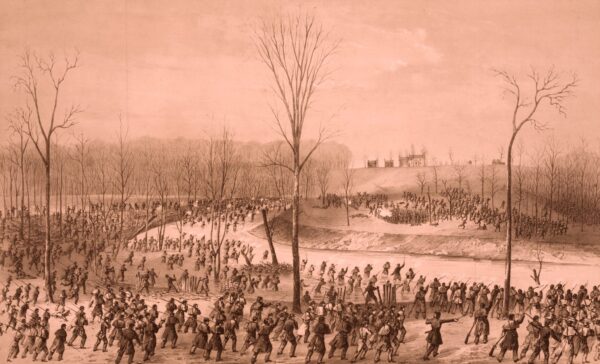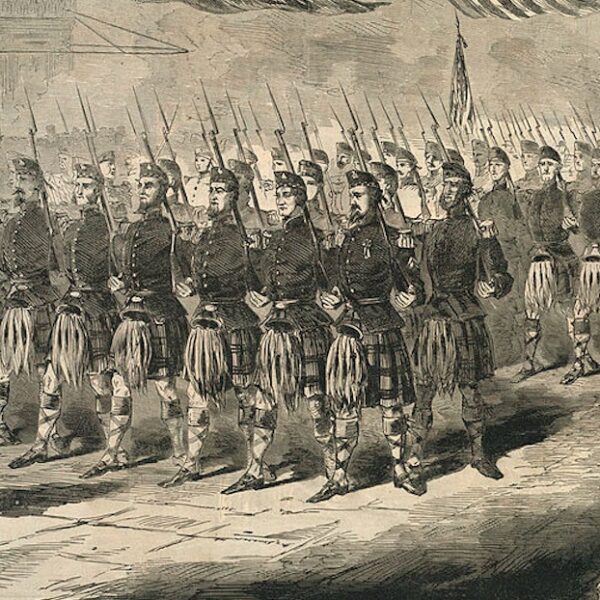 Zethyn McKinley
Zethyn McKinleyThe monument to Admiral David G. Farragut in New York City’s Madison Square Park.
On a recent trip to New York City, I was strolling around Madison Square Park, grabbing some extra steps before treating myself to a scoop of gelato. That’s when I noticed a commanding statue of Admiral David Farragut, the celebrated Civil War naval commander. My first thought was a simple question: Why is he here in a New York City park? Was he born here, or did he do something notable for the city? While I was generally familiar with his wartime role, I quickly learned that there was more to his story—more hidden from view—specifically his surprising southern roots, which are noted on the right-hand wing (east side) of the sculpture. As I soon discovered, his is a story that blends southern heritage and unwavering Union loyalty, stretches all the way to California, and even includes a significant role in President Abraham Lincoln’s funeral.
A Different Kind of Civil War Hero
Most of us know of Farragut’s contributions to the Union cause as critical to Federal success. He understood that controlling the country’s southern waterways was paramount to squeezing the Confederacy. His audacious capture of New Orleans in April 1862 strategically crippled the South’s largest city and most vital port. Two years later, his command at the Battle of Mobile Bay—and his famous quote “Damn the torpedoes! … Full speed ahead!”—became an enduring symbol of courage. (Exactly what he said at this battle is contested; the U.S. Naval Institute dug into it in a 2014 article.) Farragut next navigated his fleet through a minefield (then called “torpedoes”) to secure the last major Confederate port on the Gulf of Mexico. These naval victories choked off Confederate supply lines, split their territory, and ultimately played a decisive role in the Union’s triumph. While U.S. Grant and Robert E. Lee commanded armies, Farragut commanded the seas, isolating the Confederacy and proving the immense power of a unified naval force.
 Library of Congress
Library of CongressDavid G. Farragut
But what I didn’t realize was how close Farragut’s naval activities had brought him back home. Born in Tennessee as James Glasgow Farragut, he was later adopted by U.S. Navy officer David Porter after his mother’s death, and he took the name “David” in his foster father’s honor. Farragut’s roots were deeply planted in the South, particularly in Louisiana where he grew up. He had a long and distinguished naval career even before the Civil War, serving in the War of 1812 and the Mexican-American War. When the secession crisis swept the nation, Farragut, despite his lifelong ties to the South, faced a profound personal choice. After long and distinguished service to the United States he opposed secession and moved his family north to Hastings-on-Hudson, New York. This decision, though seemingly straightforward to us now, was a monumental act of conviction, severing personal and social ties in favor loyalty to country.
Farragut’s stone and bronze statue in New York City’s Madison Square Park can be seen as evidence that New York not only embraced him in return, but adopted him as their own. In the words of the city’s Merchant’s Committee, who feted the returning admiral at a ceremony in December 1864:
Resolved, That the City of New York, following the example of the great free cities of the world, in doing honor to their illustrious countrymen, honors itself by tendering to Admiral Farragut an invitation to become a resident thereof, and that the committee be appointed to devise the best mode of carrying this resolution into effect, so that the man, his achievements, and his fame, may belong to the city.
Farragut responded, “I came here, I can hardly say as a refugee, but being forced out of the South, where I had resided more than forty years; came naturally to this city as the metropolis of the country, and made my resting-place on the banks of the Hudson.”1
 National Park Service
National Park ServiceAugustus Saint-Gaudens
Rise of a Monument and an Artist
New York wasn’t the only city to memorialize Farragut and erect statues in his honor. However, the Madison Square Park statue has a history of its own: It was the first major public commission for famed sculptor Augustus Saint-Gaudens. In collaboration with architect Stanford White, Saint-Gaudens rose in popularity following this project and ushered in a new style of American public sculpture. His detailed, realistic portrayal of Farragut drew acclaim from the press and critics, while sculpting his role in promoting American heroism and shaping public memory.
Connecting the Past to the Present
As I dug deeper, I discovered other fascinating layers to Farragut’s story. For example, he created and oversaw Mare Island Navy Yard near San Francisco in San Pablo Bay—the first U.S. Navy base established in the Pacific Ocean. This discovery further piqued my interest because as a child I regularly traveled near this Vallejo base. My grandfather lived about 20 minutes from there and would drive me over nearby bridges to see the ships in port; he had been in the Coast Guard and still liked to patrol his nearby waters. Little did I know that the famed Admiral Farragut had a hand in developing the very region that helped shape my childhood. I also learned that he was a pallbearer for President Lincoln’s funeral alongside other Union military officers like Grant and Henry Halleck.
This story is exactly what “Unhidden History” is about: How stumbling across history around you brings more to the surface—more to life. Even a well-known Civil War figure has layers left to discover and disclose. What I appreciate the most about this particular finding was the strength of a man’s conviction to stand for something he believed in and to fight for it, regardless of where he came from. Despite his heritage, Farragut assimilated into the New York fabric. When I tried to take pictures of his statue, I struggled to get him alone, as new people would come and sit upon his steps with a lunch or a cup of coffee and even a fitness video production.
David Farragut traveled the seas in the name of the United States since he was nine years old. His love for his country is notable, choosing his principles over heritage. His contributions helped shape the Civil War and, in a small way, even my childhood.
Zethyn McKinley is a freelance writer and editor with an interest in history, technology, and politics. Beyond her research and writing, she is a certified yoga teacher and blogger at 360 Yoga, where she shares insights on finding physical and mental balance. She resides in California’s Central Valley.
Notes
The Life of David Glasgow Farragut, First Admiral of the United States Navy (D. Appleton and Company: 1891), 478.
Related topics: naval warfare




